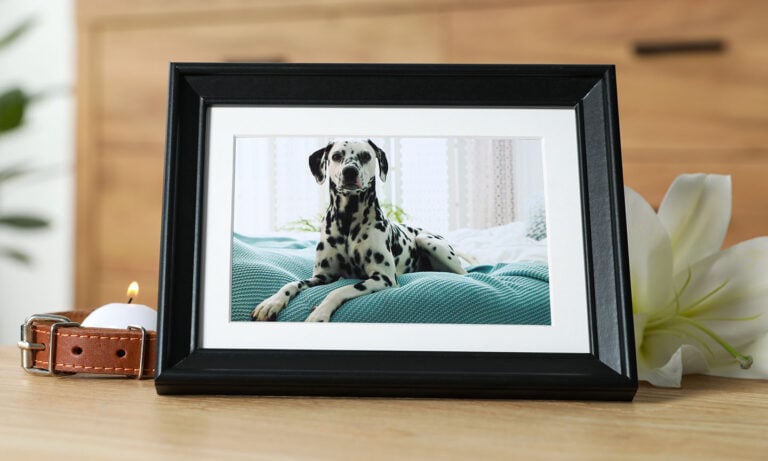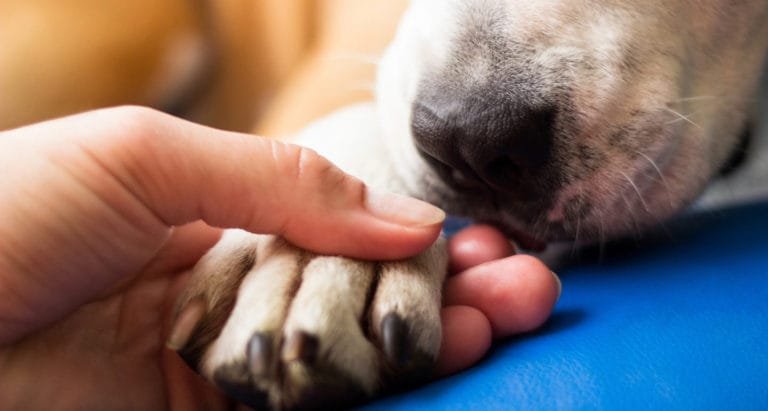Deciding when to put a beloved old or sick dog down can be one of the most heart wrenching decisions that pet caregivers will ever have to make. Unfortunately, it’s an issue that faces many parents of sick and aging pets, like the carers of Marley, a 13-year-old female Golden Retriever mix. Marley was diagnosed with presumptive pancreatic cancer that involved her liver in April 2019, when I first met her.
Thankfully, there’s help for pet caregivers struggling with this decision. The Quality of Life Scale I created in 2004 can help guide parents like Marley’s to make the right choice for their beloved companions. By answering questions about their pet, carers can determine a quality of life score. The higher the score, the better a pet’s quality of life.
When I first met Marley, she had been undergoing symptomatic treatment to reduce her vomiting and diarrhea. At her first consultation with me, her carers said she had been feeling better on those medications. Together, we assessed Marley’s condition using the Quality of Life Scale, and determined that her score was high, indicating a good quality of life. I recommended a range of care, from supplements to low-dose chemotherapy to using diapers for her incontinence, among other tactics. Thankfully, at that time, we did not have to consider euthanasia.
Over the past 15 years, thousands of pet caregivers have thanked me for providing decision-making guidance with my Quality of Life Scale. Veterinarians, their staff and pet carers tell me that using this tool has really been helpful as they lovingly provide palliative care, hospice or “pawspice” care for pets that are approaching the end of life.
What Is the Quality of Life Scale?
My goal, when I first designed the Quality of Life Scale, was to help improve quality of life for pets in decline by calling attention to criteria that carers might be able to improve. But many pet caregivers also felt that using the Quality of Life Scale to decide when to put their dog down reduced their personal angst, guilt and anguish, as they wrestled with subjective feelings and emotional decision making.
The Quality of Life Scale, also known as the HHHHHMM or H5M2 Quality of Life Scale, helps caregivers focus on their pet’s well-being instead of their own personal emotional regret and guilt feelings. They become able to move into thinking from their pet’s perspective, asking if life is worth living anymore. The Quality of Life Scale helps carers make decisions for their pet’s sake and in their pet’s best interest to avoid unnecessary and relentless suffering as their beloved pet approaches death.
The Quality of Life Scale’s scoring system uses 0 for bad and 10 for normal. It asks pet caregivers to assess seven basic criteria that compose their pets’ quality of life. If we can improve the score on one or two failing criteria by 30-50 percent, the patient’s quality of life may improve greatly and we feel ethically justified in continuing pawspice care. This allows time to embrace an integrative approach and provide medications to slow down the conditions that are causing the pet’s decline.
The scale can be used on an as-needed basis: weekly, daily, even hourly. The acronym’s five H’s stand for hurt, hunger, hydration, hygiene and happiness. Its two M’s stand for mobility and “more good days than bad days.” Evaluating and giving honest scores to these criteria assists the veterinary team and helps pet carers face reality. It helps them struggle through the difficult and emotionally draining process of making the final call to provide the gift of compassionate euthanasia to assure a peaceful and painless passing for a beloved pet.
Deciding When to Put a Dog Down Using the Quality of Life Scale
Pet caregivers can use this Quality of Life Scale to determine the success of pawspice care. Score patients using a scale of 0 to 10, with 10 being ideal and 0 being the worst-case scenario.
Hurt: Score from 0-10
The biggest concern that most carers have is that their pet does not have pain. Adequate pain control and breathing ability are of top concern. If the pet can’t breathe properly, nothing else matters. Is oxygen supplementation necessary? Is the pet's pain well managed? Bone cancer pain, for example, is often under treated. If a dog has bone cancer, it is important to use multimodality pain control, which means several medications, with some being given every eight hours. If pain can’t be adequately controlled, life is no longer worth living for the pet.
Hunger: Score from 0-10
Evaluating hunger and assuring adequate nutrition is essential to maintain a good end of life pawspice program. Is the pet eating enough? Does hand feeding or syringe feeding help? Does the pet need a feeding tube? When the pet refuses nutrition, the quality of life will decline rapidly toward death.
Hydration: Score from 0-10
It is essential to know if the pet is dehydrated because that becomes another condition that ruins quality of life. For patients who are not drinking enough water, it is very convenient to give subcutaneous fluids daily to supplement fluid intake. Ask your veterinary team to teach you how to give subcutaneous fluids at home.
Hygiene: Score from 0-10
Sick animals may soil themselves and lie in their waste for hours. It is essential to keep frail pets clean during end of life care to maintain quality of life. The pet should be brushed and cleaned often, particularly after going to the bathroom. Avoid pressure sores by using soft bedding. It is essential to keep all wounds clean.
Happiness: Score from 0-10
The human-animal bond is a treasured relationship that should be maintained during pawspice. Does the pet express joy and interest? Is the pet responsive to family or toys? Is the pet depressed, lonely, anxious, bored or afraid? Can the pet's bed be moved closer to family activities? A non-responsive pet is no longer enjoying the human-animal bond, which is a big driver for continuing life. If there is no tail wagging, no happy facial expressions, no snuggling and no two-way exchange of love, the pet is enduring a poor quality of life.
Mobility: Score from 0-10
Providing care becomes very demanding, especially when larger dogs lose their mobility. Can the dog get up without assistance? Does the dog need a floor mat to keep from slipping? Does the dog need human or mechanical help to walk, such as a ramp, lifting harness or a wheel cart? Does the dog feel like going for a walk? Is the pet having seizures or stumbling? In the case of bone cancer, for example, some caregivers feel that euthanasia is preferable to amputation. However, animals with limited mobility may be very alert and responsive, and can have a good quality of life as long as caregivers are committed to meeting their pet’s extra needs. Lack of mobility in large and giant breed dogs is often the quality of life tipping point for the decision to help them transition.
More Good Days Than Bad Days: Score from 0-10
When bad days outnumber good days, quality of life might be too compromised. Animals do not live for the future. Animals only know the now, and if that means continuous pain or suffering, it is too frustrating and inhumane for them to go on living. When a healthy human-animal bond is no longer possible, the caregivers must be made aware that the end is near. The decision for euthanasia needs to be made if the pet is enduring prolonged, futile suffering. It is ideal when a pet’s death comes peacefully and painlessly at home, but this is the exception. End of life pets often need the helping hand of their primary veterinarian or a house call veterinarian to pass away painlessly.
Add up all the scores for the seven criteria. A total over 35 points represents acceptable quality of life to continue with pet hospice.
The Quality of Life Scale helps carers to simultaneously and consistently focus on the management of pain and symptoms to improve quality of life. This approach often gains longer survival times with improved quality of life for end-of-life patients and gives us room to provide palliative medication for their life-limiting disease.
That was the case with Marley. At her 4-month recheck, her carers said, “She seems to be getting younger!”
Marley has done very well on her supplements and on metronomic (low-dose) chemotherapy, which is slowing down her pancreatic cancer. However, Marley has continued to lose more weight. Together, her caregivers and medical professionals will continue monitoring her quality of life using the above criteria. For Marley and pets like her, the Quality of Life Scale has proven to be one of the best tools for deciding when to put down a beloved dog.
Read More
Share:











